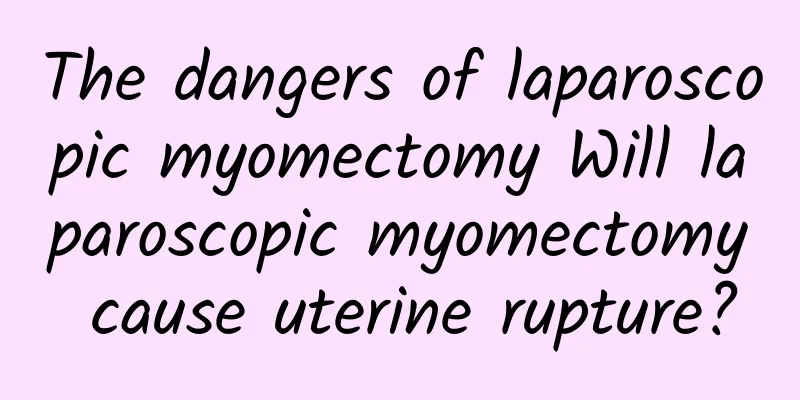The dangers of laparoscopic myomectomy Will laparoscopic myomectomy cause uterine rupture?

|
Uterine fibroids are the most common benign tumors of reproductive organs in women of childbearing age, with an incidence of 20% to 30%. They are also the cause of 5% to 10% of infertility. With the increase in the number of women who give birth later in life and the advantages of laparoscopic surgery as a minimally invasive surgery, laparoscopic myomectomy (LM) has been widely developed in recent years and has become the preferred treatment method for women with uterine fibroids. However, a retrospective analysis of the clinical data of 25 patients with uterine rupture after LM surgery reported at home and abroad showed that the risk of uterine rupture increases after any uterine surgery, during pregnancy and delivery. LM is different from laparotomy. The surgical method and instruments cannot completely suture the uterine muscle layer. Excessive use of Monopolar or bipolar electrocoagulation to block blood vessels can interfere with the healing of the uterine myometrium and increase the risk of rupture. In recent years, with the increase in the cesarean section rate, clinicians have greatly improved their awareness of the prevention of uterine rupture in subsequent pregnancy after cesarean section, but the understanding of LM on uterine rupture caused by subsequent pregnancy is still significantly insufficient. LM is developing more and more widely, and the incidence of uterine rupture after LM, the high-risk period, postoperative contraception time and delivery method have become issues that relevant medical personnel need to pay close attention to. For patients who become pregnant after LM surgery, clinical monitoring should be equivalent to that of scar uterine pregnancy after cesarean section. The medical history should be carefully inquired, the importance of prenatal and postnatal care should be publicized, the health awareness of pregnant women should be improved, and the delivery process should be closely observed. Attention should always be paid to the possibility of uterine rupture, and symptoms and signs of threatened uterine rupture should be discovered in time, such as: pathological contraction ring, early hematuria, maternal irritability, uterine tonic contraction with tenderness in the lower segment. Special attention should be paid to the fact that in some cases, uterine rupture may not be accompanied by immediate changes in fetal heart rate. Confirmed patients should be actively rescued, multiple intravenous channels should be opened quickly, and preoperative preparations should be made to avoid delaying the operation. For patients with larger fibroids, intramural fibroids, uterine cornu or posterior uterine fibroids, or unencapsulated adenomyomas, monitoring during pregnancy and delivery should be strengthened to ensure the safety of mother and baby. Most scholars believe that patients after LM surgery should be advised to use contraception for 6 months to 1 year based on the intraoperative and postoperative recovery. For patients with subserosal fibroids and intramural fibroids who did not enter the uterine cavity during resection, contraception should be used for 6 months, and for patients with multiple intramural fibroids and the uterine cavity, contraception should be used for 1 year. Some scholars believe that three-dimensional Doppler ultrasound can be used to evaluate scar healing after LM surgery, and adequate uterine blood perfusion may indicate good wound healing and hematoma removal. At the same time, it is recommended that if ultrasound reveals defects in the uterine scar or uneven thickness of the lower segment, partial loss of muscle fiber structure in the lower segment of the uterus, or bulging of the amniotic sac from the thin lower segment of the uterus toward the bladder on the anterior abdominal wall of the mother, threatened uterine rupture should be considered. In summary, compared with laparotomy, LM can reduce postoperative pain, reduce postoperative organ adhesions, shorten hospital stays, relieve pain, have a low recurrence rate after treatment, and a high overall pregnancy rate (33%~65%). So far, studies on uterine rupture during LM pregnancy have shown that this is still a low-probability event. However, as escort medical staff, we should further improve our awareness of prevention, reduce the occurrence of uterine rupture, and ensure the safety of mother and baby. (Submitted by Jiangxi Provincial Maternal and Child Health Hospital) |
<<: What is the process of myomectomy? How is myomectomy performed?
>>: What affects the cost of uterine fibroid surgery? How much does uterine fibroid surgery cost?
Recommend
9 dietary suggestions for gout to prevent diseases of affluence
Whether in the ward, outpatient clinic or friends...
How to treat female Bartholin's gland cyst
The treatments for Bartholin's gland cysts in...
Can you get pregnant 10 days after your period ends? What should you pay attention to?
Most men and women know that they cannot have sex...
What should you eat after a miscarriage? Doctors recommend these 2 meals
I believe that no matter what the circumstances, ...
Does bacterial vaginosis affect menstruation?
Will bacterial vaginosis cause irregular menstrua...
What are the chances of curing bacterial vaginosis?
The four major issues in the treatment of bacteri...
Can I get pregnant and have a baby with endometriosis?
Patients with endometriosis can get pregnant and ...
Regular life can help women prevent ovarian cysts
Ovarian cyst disease is a gynecological disease. ...
The harm of pelvic inflammatory disease to female fertility
For female friends, pelvic inflammatory disease i...
Endometrial repair method helps stop bleeding in anovulatory functional bleeding
Xiaoyun has always had irregular menstruation in ...
What is adnexitis?
There are many kinds of gynecological diseases, a...
Why do women get uterine effusion?
Among gynecological diseases, uterine effusion is...
Learn more about the factors that lead to adnexitis
Women are always troubled by various gynecologica...
It’s time to clear out the old stool during the Chinese New Year! 5 nutrients are good for defecation
Before the Chinese New Year, it’s time to clear o...
What should we do to prevent endometrial tuberculosis?
It is necessary for female friends to learn about...









